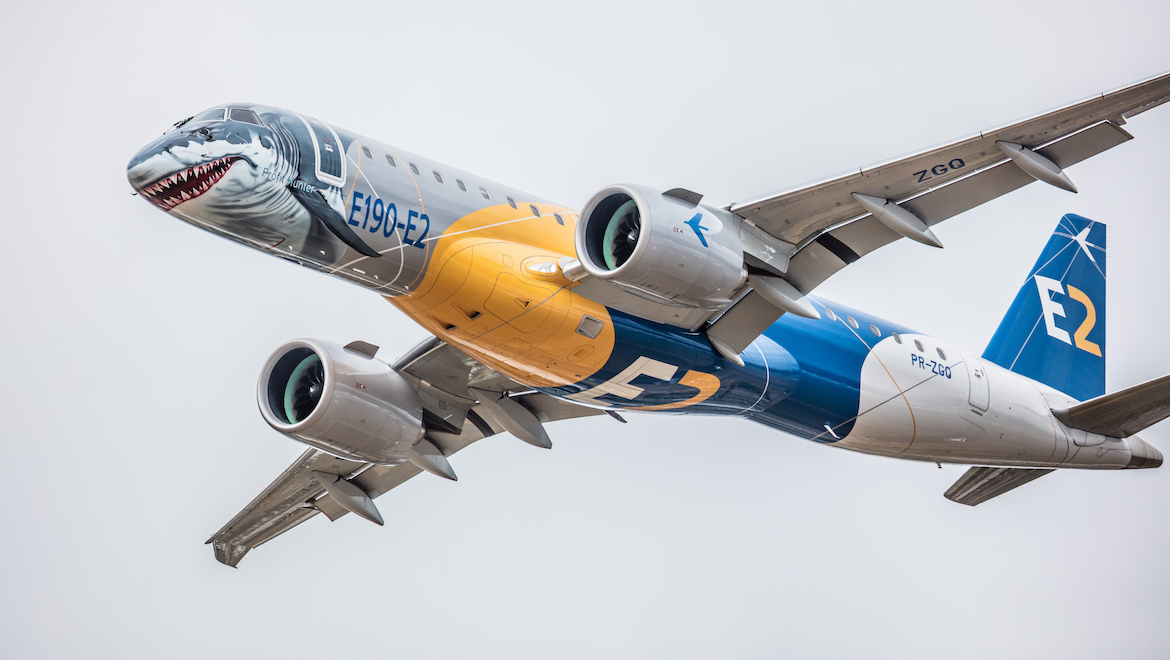
Embraer says airlines will require 10,550 new aircraft with up to 150 seats over the next 20 years.
The outlook in Embraer’s 2019-2038 market outlook published on June 18 is broadly in line with the manufacturer’s 2018 forecast.
The only slight variance in numbers in the market outlook for 2019-2038 was a forecast of 10 more aircraft in this size range for the Latin American market (to 1,150) and 10 fewer for the Asia Pacific region to 2,990 (after a revision from 3010 to 3000 in the interim).
Asia Pacific is forecast to take the biggest market share in this segment with 28 per cent, behind North America at 27 per cent.
Embraer said the value of these new aircraft was about US$600 billion (A$867 billion). Of the total, it said replacement of aging aircraft would represent 45 per cent of new deliveries, with 55 per cent comprising market growth.
The aircraft manufacturer said connectivity for mid-size cities and long-thin routes would drive a worldwide demand for 8,230 jets with up to 150 seats. Of those 57 per cent would support market growth and the remaining 43 per cent will replace aging aircraft.

Asia Pacific
Embraer said in its outlook that improved infrastructure and traffic conditions in China, alongside China’s global investment, new startups in the marketplace and India’s highest air transport growth rates in the world would see demand in the region in the next 20 years for 2,030 jets up to 150 seats, 960 turboprops and 7,910 150-210-seat aircraft in the Asia Pacific region.
This would increase the fleet in service of these aircraft the market from 1,620 in 2018 to 3,980 in 2038.
“By 2038, 20,500 150- to 210-seat narrow-body aircraft will be delivered worldwide, as jets at the mid-range of the capacity spectrum will continue to have strong demand,” Embraer said in the report.
Further, short-haul operations were forecast to drive a worldwide demand for 2,320 turboprops. Of those, 49 per cent would support market growth and the remaining 51 per cent would replace aging aircraft.
Embraer Commercial Aviation chief executive John Slattery noted the airline industry transported more than four billion passengers in 2018. Of those some one billion were estimated to have flown on an aircraft in the sub 150-seat sector.
He said the segment connected more than 15,000 markets (60 per cent of all markets directly linked) and it was the single service provider in about half of them.
Slattery said that despite great results shown by the industry since 2015, when the earnings before interest and tax (EBIT) margin touched an unprecedented level of 8.6 per cent, margins had fallen systematically to 5.8 per cent in 2018.
“For sure, those numbers are still strong, but it’s quite reasonable to consider that the peak of this great cycle is behind us. In every region we see similar impacts on the airlines’ margins,” he said.
“The up to 150-seat segment represents a very adaptable alternative to sustainable growth for the airline industry as it can serve multiple missions, with a very low risk and now – following the arrival of the E2 Family – with the most efficient single-aisle platform.”
In the #Embraer Pavilion at the #ParisAirShow are two incredible experiences that showcase the class-leading efficiency and quietness of the #E2 #ProfitHunter. We try them out. #PAS19 #Embraer50 #EmbraerStories pic.twitter.com/gMxCpvjsYv
— Embraer (@embraer) June 19, 2019
|
Region |
Deliveries |
Share |
|
Asia-Pacific |
2,990 |
28% |
|
North America |
2,780 |
26% |
|
Europe |
2,240 |
21% |
|
Latin America |
1,150 |
11% |
|
CIS |
580 |
6% |
|
Africa |
450 |
4% |
|
Middle East |
360 |
4% |
|
World (2019-2038) |
10,550 |
|











